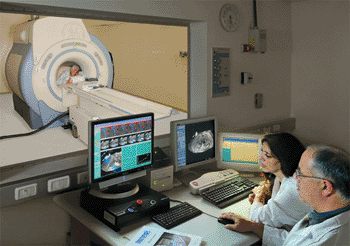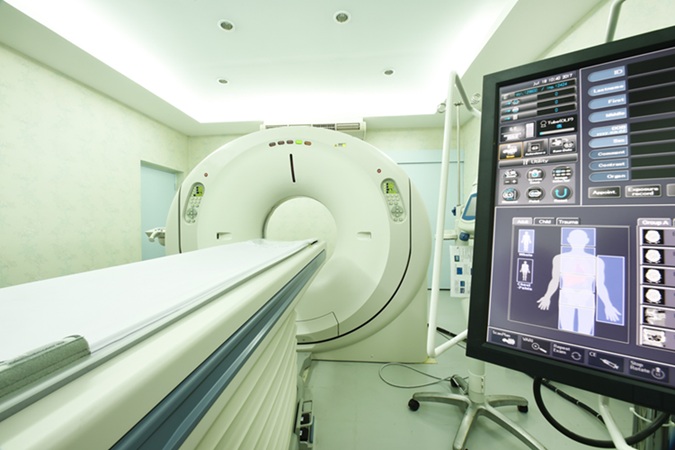MR-guided, Focused Ultrasound Therapy Company Receives US Approval to Treat Bone Pain
|
By MedImaging International staff writers Posted on 14 Jan 2013 |

Image: Patient undergoing ExAblate MRI-guided focused ultrasound (Photo courtesy of InSightec).
A novel combination of imaging technologies called magnetic resonance-guided focused ultrasound therapy (MRgFUS) is now being used to treat bone pain. Physicians use the MRI to plan and guide the therapy and track treatment outcome. The focused ultrasound acoustic energy kills the nerves causing the pain from bone metastases, resulting in a fast drop in pain.
InSightec, Ltd. (Tirat Carmel, Israel) reported that it has received US Food and Drug Administration (FDA) approval for the ExAblate MRI-guided focused ultrasound for treatment of painful bone metastases in patients who are not candidates for or refuse to undergo radiation treatment.
This is the second FDA approval for ExAblate, which received FDA approval in 2004 as a noninvasive, outpatient therapy for uterine fibroids. GE Healthcare (Chalfont St. Giles, UK) is a minority shareholder of Insightec, Ltd. and is a distributor of ExAblate in many countries worldwide.
InSightec’s ExAblate system is exclusively compatible with GE Healthcare’s normal and wide-bore MRI systems, including Signa HDxt 1.5T, Signa HDxt 3.0T, Optima MR450 & 450w, and Discovery MR750 & 750w. It combines therapeutic acoustic ultrasound waves with continuous guidance and treatment monitoring by MRI.
“The FDA approval of ExAblate is an exciting next step in GE’s investment in InSightec,” said Tom Gentile, president and CEO of GE Healthcare Systems and InSightec board member. “Pain is the most common and most severe symptom for patients suffering from bone cancer; we believe that ExAblate can help significantly improve the quality of life for patients. This is the first approved oncology application of ExAblate and we are excited that InSightec will continue researching in this area to expand the applications of this product.”
Bone metastases ensue when cancer cells move from their primary site and spread to other parts of the body. According to the American Cancer Society, more than two-thirds of breast and prostate cancers that metastasize spread to the bones. This also happens in up to 30% of bladder, metastatic lung, and thyroid cancers.
Pain is the most common and severe symptom of bone metastases and is usually treated with radiation therapy. However, up to 30% of patients either do not respond to radiation therapy or are unable to undergo radiation for pain relief. The clinical study findings to support the premarket approval (PMA) approval showed that ExAblate therapy offers these patients considerably less pain and also improves patient well-being and function. Patients also reported reduced use of medications.
“The new FDA approval of ExAblate for pain palliation offers new options for cancer patients with crippling bone pain who are seeking pain-management options but are no longer eligible for radiation treatment,” said Dr. Kobi Vortman, president of InSightec. “This second approval represents a significant milestone in our quest to provide noninvasive treatment alternatives to improve patients’ quality of life and establish ExAblate MRI-guided focused ultrasound for new clinical uses.”
ExAblate is the only FDA-approved MRI-guided focused ultrasound system for treating uterine fibroids and bone metastases related pain management. It has also received European CE marking for uterine fibroids, bone metastases, and adenomyosis. ExAblate is a GE healthymagination-validated product and will be comarketed by GE Healthcare as InSightec’s distributor.
Related Links:
InSightec
GE Healthcare
InSightec, Ltd. (Tirat Carmel, Israel) reported that it has received US Food and Drug Administration (FDA) approval for the ExAblate MRI-guided focused ultrasound for treatment of painful bone metastases in patients who are not candidates for or refuse to undergo radiation treatment.
This is the second FDA approval for ExAblate, which received FDA approval in 2004 as a noninvasive, outpatient therapy for uterine fibroids. GE Healthcare (Chalfont St. Giles, UK) is a minority shareholder of Insightec, Ltd. and is a distributor of ExAblate in many countries worldwide.
InSightec’s ExAblate system is exclusively compatible with GE Healthcare’s normal and wide-bore MRI systems, including Signa HDxt 1.5T, Signa HDxt 3.0T, Optima MR450 & 450w, and Discovery MR750 & 750w. It combines therapeutic acoustic ultrasound waves with continuous guidance and treatment monitoring by MRI.
“The FDA approval of ExAblate is an exciting next step in GE’s investment in InSightec,” said Tom Gentile, president and CEO of GE Healthcare Systems and InSightec board member. “Pain is the most common and most severe symptom for patients suffering from bone cancer; we believe that ExAblate can help significantly improve the quality of life for patients. This is the first approved oncology application of ExAblate and we are excited that InSightec will continue researching in this area to expand the applications of this product.”
Bone metastases ensue when cancer cells move from their primary site and spread to other parts of the body. According to the American Cancer Society, more than two-thirds of breast and prostate cancers that metastasize spread to the bones. This also happens in up to 30% of bladder, metastatic lung, and thyroid cancers.
Pain is the most common and severe symptom of bone metastases and is usually treated with radiation therapy. However, up to 30% of patients either do not respond to radiation therapy or are unable to undergo radiation for pain relief. The clinical study findings to support the premarket approval (PMA) approval showed that ExAblate therapy offers these patients considerably less pain and also improves patient well-being and function. Patients also reported reduced use of medications.
“The new FDA approval of ExAblate for pain palliation offers new options for cancer patients with crippling bone pain who are seeking pain-management options but are no longer eligible for radiation treatment,” said Dr. Kobi Vortman, president of InSightec. “This second approval represents a significant milestone in our quest to provide noninvasive treatment alternatives to improve patients’ quality of life and establish ExAblate MRI-guided focused ultrasound for new clinical uses.”
ExAblate is the only FDA-approved MRI-guided focused ultrasound system for treating uterine fibroids and bone metastases related pain management. It has also received European CE marking for uterine fibroids, bone metastases, and adenomyosis. ExAblate is a GE healthymagination-validated product and will be comarketed by GE Healthcare as InSightec’s distributor.
Related Links:
InSightec
GE Healthcare
Latest Ultrasound News
- AI-Powered Lung Ultrasound Outperforms Human Experts in Tuberculosis Diagnosis
- AI Identifies Heart Valve Disease from Common Imaging Test
- Novel Imaging Method Enables Early Diagnosis and Treatment Monitoring of Type 2 Diabetes
- Ultrasound-Based Microscopy Technique to Help Diagnose Small Vessel Diseases
- Smart Ultrasound-Activated Immune Cells Destroy Cancer Cells for Extended Periods
- Tiny Magnetic Robot Takes 3D Scans from Deep Within Body
- High Resolution Ultrasound Speeds Up Prostate Cancer Diagnosis
- World's First Wireless, Handheld, Whole-Body Ultrasound with Single PZT Transducer Makes Imaging More Accessible
- Artificial Intelligence Detects Undiagnosed Liver Disease from Echocardiograms
- Ultrasound Imaging Non-Invasively Tracks Tumor Response to Radiation and Immunotherapy
- AI Improves Detection of Congenital Heart Defects on Routine Prenatal Ultrasounds
- AI Diagnoses Lung Diseases from Ultrasound Videos with 96.57% Accuracy
- New Contrast Agent for Ultrasound Imaging Ensures Affordable and Safer Medical Diagnostics
- Ultrasound-Directed Microbubbles Boost Immune Response Against Tumors
- POC Ultrasound Enhances Early Pregnancy Care and Cuts Emergency Visits
- AI-Based Models Outperform Human Experts at Identifying Ovarian Cancer in Ultrasound Images
Channels
Radiography
view channel
World's Largest Class Single Crystal Diamond Radiation Detector Opens New Possibilities for Diagnostic Imaging
Diamonds possess ideal physical properties for radiation detection, such as exceptional thermal and chemical stability along with a quick response time. Made of carbon with an atomic number of six, diamonds... Read more
AI-Powered Imaging Technique Shows Promise in Evaluating Patients for PCI
Percutaneous coronary intervention (PCI), also known as coronary angioplasty, is a minimally invasive procedure where small metal tubes called stents are inserted into partially blocked coronary arteries... Read moreMRI
view channel
AI Tool Tracks Effectiveness of Multiple Sclerosis Treatments Using Brain MRI Scans
Multiple sclerosis (MS) is a condition in which the immune system attacks the brain and spinal cord, leading to impairments in movement, sensation, and cognition. Magnetic Resonance Imaging (MRI) markers... Read more
Ultra-Powerful MRI Scans Enable Life-Changing Surgery in Treatment-Resistant Epileptic Patients
Approximately 360,000 individuals in the UK suffer from focal epilepsy, a condition in which seizures spread from one part of the brain. Around a third of these patients experience persistent seizures... Read more
AI-Powered MRI Technology Improves Parkinson’s Diagnoses
Current research shows that the accuracy of diagnosing Parkinson’s disease typically ranges from 55% to 78% within the first five years of assessment. This is partly due to the similarities shared by Parkinson’s... Read more
Biparametric MRI Combined with AI Enhances Detection of Clinically Significant Prostate Cancer
Artificial intelligence (AI) technologies are transforming the way medical images are analyzed, offering unprecedented capabilities in quantitatively extracting features that go beyond traditional visual... Read moreNuclear Medicine
view channel
Novel Radiolabeled Antibody Improves Diagnosis and Treatment of Solid Tumors
Interleukin-13 receptor α-2 (IL13Rα2) is a cell surface receptor commonly found in solid tumors such as glioblastoma, melanoma, and breast cancer. It is minimally expressed in normal tissues, making it... Read more
Novel PET Imaging Approach Offers Never-Before-Seen View of Neuroinflammation
COX-2, an enzyme that plays a key role in brain inflammation, can be significantly upregulated by inflammatory stimuli and neuroexcitation. Researchers suggest that COX-2 density in the brain could serve... Read moreGeneral/Advanced Imaging
view channel
AI-Powered Imaging System Improves Lung Cancer Diagnosis
Given the need to detect lung cancer at earlier stages, there is an increasing need for a definitive diagnostic pathway for patients with suspicious pulmonary nodules. However, obtaining tissue samples... Read more
AI Model Significantly Enhances Low-Dose CT Capabilities
Lung cancer remains one of the most challenging diseases, making early diagnosis vital for effective treatment. Fortunately, advancements in artificial intelligence (AI) are revolutionizing lung cancer... Read moreImaging IT
view channel
New Google Cloud Medical Imaging Suite Makes Imaging Healthcare Data More Accessible
Medical imaging is a critical tool used to diagnose patients, and there are billions of medical images scanned globally each year. Imaging data accounts for about 90% of all healthcare data1 and, until... Read more
Global AI in Medical Diagnostics Market to Be Driven by Demand for Image Recognition in Radiology
The global artificial intelligence (AI) in medical diagnostics market is expanding with early disease detection being one of its key applications and image recognition becoming a compelling consumer proposition... Read moreIndustry News
view channel
GE HealthCare and NVIDIA Collaboration to Reimagine Diagnostic Imaging
GE HealthCare (Chicago, IL, USA) has entered into a collaboration with NVIDIA (Santa Clara, CA, USA), expanding the existing relationship between the two companies to focus on pioneering innovation in... Read more
Patient-Specific 3D-Printed Phantoms Transform CT Imaging
New research has highlighted how anatomically precise, patient-specific 3D-printed phantoms are proving to be scalable, cost-effective, and efficient tools in the development of new CT scan algorithms... Read more
Siemens and Sectra Collaborate on Enhancing Radiology Workflows
Siemens Healthineers (Forchheim, Germany) and Sectra (Linköping, Sweden) have entered into a collaboration aimed at enhancing radiologists' diagnostic capabilities and, in turn, improving patient care... Read more



















